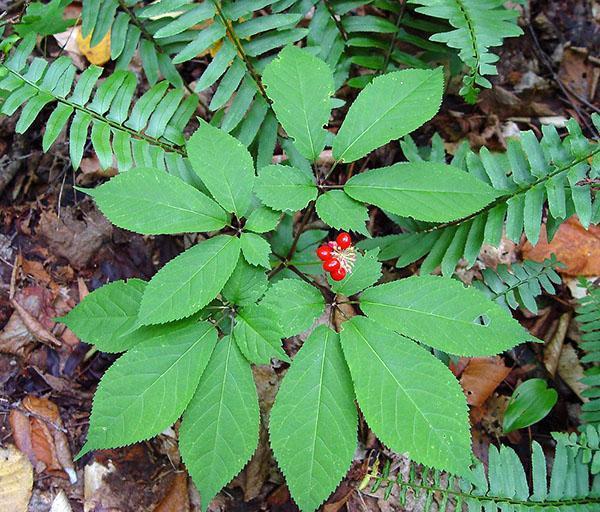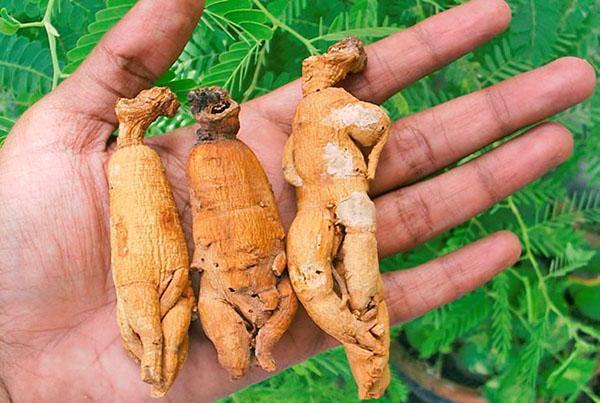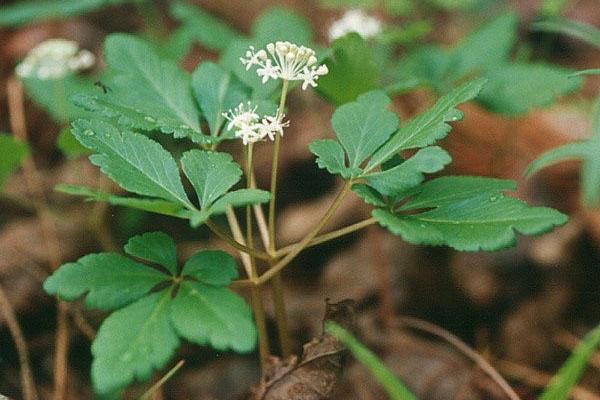Botanical description, habitat and features of ginseng cultivation
 Ginseng, recognized as a symbol of oriental medicine, is not only the most valuable "green doctor", but also one of the rarest medicinal plants. In ancient times, Chinese doctors considered the ginseng root to be practically miraculous, capable of lifting seriously ill patients to their feet, restoring youth and strength.
Ginseng, recognized as a symbol of oriental medicine, is not only the most valuable "green doctor", but also one of the rarest medicinal plants. In ancient times, Chinese doctors considered the ginseng root to be practically miraculous, capable of lifting seriously ill patients to their feet, restoring youth and strength.
The plant received recognition in official medicine relatively recently, but the need for roots turned out to be so great that the natural range of ginseng has been reduced many times, and wild specimens are legally protected.
What ginseng looks like

Common ginseng, recognized as the most valuable from the point of view of medicine, is a herbaceous perennial, with one or less often several erect stems ranging in height from 30 to 70 centimeters. A thin, no more than 6 mm thick shoot in the upper part is crowned with large split foliage, consisting of five oval or ovoid parts. The dense, finger-like leaves of ginseng are attached to the stem with strong petioles, have finely serrated edges and a maximum length of 15 cm.
 In the middle of summer, ginseng blooms, forming an umbrella inflorescence, about three centimeters in diameter and consisting of 15–40 small greenish buds. The ginseng flower depicted in the photo can hardly be called bright or decorative. White or pinkish corollas with a green toothed calyx and five petals are pollinated by insects. When flowering is over, ovaries appear in place of flowers, ripening in the last days of summer or in September.
In the middle of summer, ginseng blooms, forming an umbrella inflorescence, about three centimeters in diameter and consisting of 15–40 small greenish buds. The ginseng flower depicted in the photo can hardly be called bright or decorative. White or pinkish corollas with a green toothed calyx and five petals are pollinated by insects. When flowering is over, ovaries appear in place of flowers, ripening in the last days of summer or in September.
 Looking at the photo of what ginseng looks like at this time, you can understand how much the appearance of a generally invisible plant changes. Rounded bright red berries with juicy pulp and 2-3 seeds inside ripen on a 10-24 cm high peduncle.
Looking at the photo of what ginseng looks like at this time, you can understand how much the appearance of a generally invisible plant changes. Rounded bright red berries with juicy pulp and 2-3 seeds inside ripen on a 10-24 cm high peduncle.
In the cold season, the aboveground part of the plant dies, but a large rhizome remains underground. It keeps the ginseng alive until warmth and carries all the accumulated useful substances. Ginseng is a long-lived plant. The older the root, the greater its mass and the higher the healing power. At the beginning of the last century, a bicentennial root was discovered in Manchuria. Today, such a giant is unlikely to be found.
Due to the high demand for medicinal raw materials, in the 19th century, a merciless hunt for ginseng began in its natural habitats. It led to a sharp decrease in the number of the population and a narrowing of the growth zone.
Where does ginseng grow
 Ginseng is a relict plant. An indirect confirmation of this is the unusual cultural area, torn in two by the Pacific Ocean. Most of the 12 types of ginseng are indigenous to the Far East, but not so long ago one of the varieties was discovered on the territory of the American continent. Today, five-leaf ginseng is grown on extensive plantations as an effective medicinal plant.
Ginseng is a relict plant. An indirect confirmation of this is the unusual cultural area, torn in two by the Pacific Ocean. Most of the 12 types of ginseng are indigenous to the Far East, but not so long ago one of the varieties was discovered on the territory of the American continent. Today, five-leaf ginseng is grown on extensive plantations as an effective medicinal plant.
In addition to the western coast of the United States, the range of ginseng covers the Korean Peninsula, Vietnam and northeastern China. Where does ginseng grow in Russia? Our country has the largest reserve of this plant raw material. Wild medicinal ginseng is found in the southern part of the Khabarovsk Territory, in the Sikhote-Alin, as well as in Primorye. Everywhere the plant is included in the list of specially protected species. There is a mention of ginseng in the Red Book of the Jewish Autonomous Region, however, live specimens have not been found here for a long time.
Wherever ginseng grows, not only the collection of roots is prohibited, but all measures are taken to preserve and increase the population.
 Today it is known for sure that the plant prefers to settle in deciduous forests, under the protection linden and hornbeams, fir, cedars, birches and maples. Ginseng loves shade, moisture, needs a nutritious loose soil. In favorable conditions, perennials can form continuous clumps. But the picture is not that happy at the moment. For example, in the Primorsky Territory, ginseng grows in many areas, but an inquisitive nature explorer is unlikely to be lucky enough to see a large group of plants.
Today it is known for sure that the plant prefers to settle in deciduous forests, under the protection linden and hornbeams, fir, cedars, birches and maples. Ginseng loves shade, moisture, needs a nutritious loose soil. In favorable conditions, perennials can form continuous clumps. But the picture is not that happy at the moment. For example, in the Primorsky Territory, ginseng grows in many areas, but an inquisitive nature explorer is unlikely to be lucky enough to see a large group of plants.
Most often, wild-growing ginseng, the number of which in Russia is in the tens of thousands, grows alone, in untouched corners of the southwestern or southeastern slopes.
How ginseng is guarded
 Of course, poachers still cause serious damage to the number of medicinal plants. However, they are not the only enemies of ginseng. The wild plant population is declining due to the deforestation of forests suitable for plant settlement, fires, and thinning of the forest floor. Unfortunately, ginseng produces few seeds. Not all of them germinate, and some of the seedlings die in the first years, and do not form a powerful valuable rhizome.
Of course, poachers still cause serious damage to the number of medicinal plants. However, they are not the only enemies of ginseng. The wild plant population is declining due to the deforestation of forests suitable for plant settlement, fires, and thinning of the forest floor. Unfortunately, ginseng produces few seeds. Not all of them germinate, and some of the seedlings die in the first years, and do not form a powerful valuable rhizome.
Planting in protected areas protects the Far East ginseng from extinction. In which nature reserve does ginseng grow? There are not one such places, but several. Today, programs to restore the number of medicinal relics are working in four reserves of the Russian Far East at once. These are "Kedrovaya Pad", as well as nature reserves Lazovsky, Bolshekhekhtsirsky, Ussuriysky.
Not only in the Primorsky Territory, but also in other parts of the country, for example, in Sakhalin and Cheboksary, ginseng is grown on specially prepared plantations, where conditions are close to natural conditions. They also receive raw materials for pharmaceutical and cosmetic products in China, Korea, the USA and Australia. At high humidity, in conditions of 20–30% illumination, plants are kept for 4–6 years. Then the ginseng roots, which have managed to accumulate a fair share of nutrients, are dug up, cleaned and dried, sorted and crushed.
 Although ginseng cultivation helps protect natural reserves and the plants themselves are indistinguishable from wild specimens, they need several years and painstaking, laborious care to mature. Therefore, botanists turned to modern science. Today, more and more ginseng is obtained through in vitro cell culture.
Although ginseng cultivation helps protect natural reserves and the plants themselves are indistinguishable from wild specimens, they need several years and painstaking, laborious care to mature. Therefore, botanists turned to modern science. Today, more and more ginseng is obtained through in vitro cell culture.